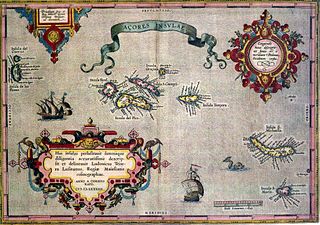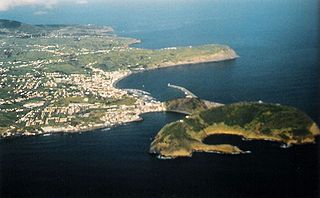 W
WThe following article describes the history of the Azores.
 W
WThe 1841 Caída da Praia earthquake, also known as the Second Caída da Praia, was a series of seismic events occurring between 12 June and 15 June 1841, on the island of Terceira in the Portuguese archipelago of the Azores. Similar in scope to the first 1614 Cáida da Praia earthquake that destroyed most of the community, this second event is noted for the systematic process to assistance, document and catalogue the events of the tragedy.
 W
WThe 1964 Rosais earthquake was a series of seismic swarms occurring in February 1964, leading to two major earthquakes on the 15 and 21 of February, resulting in the destruction of most of the habitable dwellings on the western part of the island of São Jorge, in the archipelago of the Azores. The event resulted in the evacuation of approximately 5,000 residents from that island to Terceira, Pico and Faial.
 W
WThe Azorean real, also known as the Azorean Moeda Insulana was the currency of the Portuguese archipelago of the Azores, used until 1931.
 W
WThe Azores Voyage of 1589, also known as Cumberland's Third Voyage, was a series of conflicts in the Azores islands between August and September 1589 by an English military joint stock expedition led by George Clifford, 3rd Earl of Cumberland, during the Anglo–Spanish War. All the islands were attacked either for provisions or the attainment of Spanish and Portuguese prizes. A number of Portuguese and Spanish ships were captured and also included a battle at Faial which resulted in the capture of the fort and the main town, which was subsequently sacked and burned. The English were able to return home unmolested with a total of thirteen prizes – the expedition was a success and with a good profit for the investors although many lives were lost to disease and storms.
 W
WGodide, or Godide Nxumalo, also known as António da Silva Pratas Godide, was a son of Ngungunhane, the last ruler of the Gaza Empire, located in modern Mozambique. He was chosen by his father as putative heir to the throne.
 W
WNgungunyane, also known as Mdungazwe Ngungunyane Nxumalo, N'gungunhana, or Gungunhana Reinaldo Frederico Gungunhana, was a tribal king and vassal of the Portuguese Empire, who rebelled, was defeated by General Joaquim Mouzinho de Albuquerque and lived out the rest of his life in exile, first in Lisbon, but later on the island of Terceira, in the Portuguese Azores.
 W
WThe District of Horta was a district of the Ilhas Adjacentes, consisting of the dependent western islands of the Azores, located in the Atlantic Ocean. The district of Horta, not to be confused with the modern municipality of Horta, existed from 1836 until 1976 when it was abolished in favour of the autonomy charter of the 1975 Portuguese Constitution.
 W
WThe District of Ponta Delgada was a district of the Ilhas Adjacentes, consisting of the dependent eastern islands of the Azores, located in the Atlantic Ocean. The district of Ponta Delgada, not to be confused with the modern municipality of Ponta Delgada, existed from 1835 until 1976 when it was abolished in the favour of the autonomy charter of the 1975 Portuguese Constitution.
 W
WSaudades da Terra is a manuscript that was published by father Gaspar Frutuoso. It forms a reference work on the knowledge of Macaronesia in the late 16th century.
 W
WWar Plan Gray was a plan for the United States to invade the Azores Islands in 1940–41 given the possibility of Germany seizing the islands. Gray is one of the many color-coded war plans created in the early 20th century. On 22 May 1941, President Franklin D. Roosevelt directed the U.S. Army and Navy to draft an official plan to occupy the Portuguese Azores. Approved by the Joint Board on 29 May, War Plan Gray called for a landing force of 28,000 troops, one half Marine and one half Army.